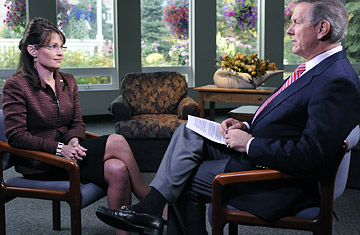
Charles Gibson talks to Republican vice-presidential candidate Governor Sarah Palin in Fairbanks, Alaska, in an interview Thursday, Sept. 11, 2008
(2 of 2)
By JAMES PONIEWOZIK
For the past few days, the entire world has been offering Charles Gibson unsolicited advice on how to interview Sarah Palin. I've done enough bad interviews in my day that I can hardly imagine handling one in front of an audience of a million kibitzers. So I'll spare you (and Gibson) my two cents on which follow-up I would have asked here and how I would have phrased this question there.
In all, Gibson's first interview with Palin proved wrong those who thought he would either offer up a volley of softballs or spring a name-the-heads-of-state quiz to try to gin up embarrassing moments. (Of course, the World News segment was on foreign policy, so it didn't provide much opportunity to get into hot-button campaign questions; he still has another day to bring up "lipstick on a pig" if he chooses to.) Instead, Gibson interviewed her — imagine this — the way you might interview a candidate for Vice President about whom people still know very little.
The one thing that strikes me is that the interview comes off much different if you read the transcript than if you watch the video. On the page, it's pretty unremarkable, even the quotes that are being picked up on the political blogs. (Palin talking about the possibility of war with Russia may have been hawkishly phrased, but it was essentially just stating a NATO treaty obligation; she didn't appear to know what the "Bush Doctrine" meant, but her agreement with the principles of the doctrine was unsurprising.)
On the screen, it was much different; the real information, it seemed, was in the tone and manner of the exchange. (On the transcript, Palin's attempt at defining the Bush Doctrine was "His worldview." On the screen, it was "His worldview?" — with a hint of a challenge in it.) She injected "Charlie" into her answers constantly, as if trying to draw him in; he kept a distanced and almost curt manner, following up briskly and often. After a few follow-ups to his question on whether the U.S. had the right to invade Pakistan to pursue terrorist leaders, he asked bluntly, "I got lost in a blizzard of words there. Is that a yes?"
Palin seemed eager and defensive in some answers, more comfortable in others. (The former, for instance, when trying to steer a question about foreign policy toward an answer about oil and energy policy; the latter when talking about, well, oil and energy policy.) She made a point of answering quickly and resolutely even if resorting to boilerplate, as if her mantra for the interview was — as she said twice when asked if she had any doubts about her readiness to be Vice President (or President) — "You can't blink."
I don't pretend to know whether more people will see Palin as nervous and unready or refreshing and outsiderish (or see Gibson as firm or contemptuous). But either way, it was definitely a different interview tonally than you would have gotten from, as she said, someone with a "big, fat rsum."
The most interesting aspect of the interview was/is its format; Gibson is interviewing her in three installments, the next two coming after the first round of the interview has already aired. Theoretically, this will allow him to adjust his questions — and her to strategize her answers — based on seeing the interview playback. It's like a sped-up version of Nixon and Frost.
And if there's one thing they have in Alaska, it's frost. And blizzards of words.
